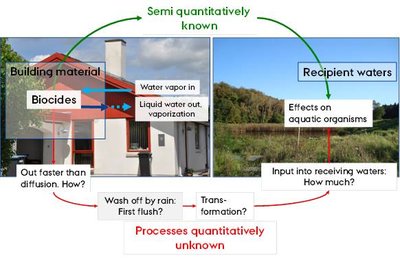Ulla E Bollmann, Post doc,
Michal Urbanczyk, PhD student,
Kai Bester, Senior Scientist
The project focuses on the leaching of biocides from building material precisely plasters and paints. In recent years houses are equipped with a thermal insulation to increase the energy efficiency of heating. Usually polymeric based plaster is used for this issue. Due to the chemical physical properties as well as an effective insulation that prevents drying the polymeric plaster surfaces stay wet and has to be protected with biocides against algae, fungi and bacteria. Previous studies showed that biocide leaching from building material is a major source in urban water pollution with biocides. As rain water run-off is directly discharged into the aquatic environment via separated sewer systems, storm water overflow and rain water infiltration, discharge of storm water run-off needs consideration. Little is known about the exact mobilization mechanism of biocides and the impact in the aquatic environment
Within this project the entire life cycle from the application in render, paint and plaster to the emission into receiving waters will be determined (fig. 1): 1. Leaching mechanisms and mobility in the material, 2. Concentrations in technical leachates (bottom of an artificial wall), 3. Concentrations in the storm water discharge (separated sewer, combined sewer, combined sewer overflow), 4. Determination of possible transformation processes.

Literature relevant for the project
Ulla E. Bollmann, Yi Ou, P. Mayer, S. Trapp, K. Bester: Polyacrylate-water partitioning of biocidal compounds: Enhancing the understanding of biocide partitioning between render and water, Chemosphere, 119, 1021-1026, 2015. doi:10.1016/j.chemosphere.2014.08.074
Ulla E. Bollmann, Camilla Tang, Eva Eriksson, Karin Jönsson, Jes Vollertsen, and Kai Bester: Biocides in urban waste water treatment plant influent at dry and wet weather: concentrations, mass flows and possible sources, Water Research, 64-74, 2014. doi:10.1016/j.watres.2014.04.014
Ulla E. Bollmann, Jes Vollertsen, Jan Carmeliet, Kai Bester: Dynamics of biocide emissions from buildings in a suburban stormwater catchment - first flush and continuous emissions, Water Research, 56, 66-76, 2014. doi:10.1016/j.watres.2014.02.033
M. Burkhardt, S. Zuleeg, R. VomBank, K. Bester, J. Carmeliet, M. Boller, T. Wangler: Leaching of biocides from façades under natural weather condition, Environmental Science and Technology, 46, 10, 5497-5503, 2012. DOI: http://pubs.acs.org/doi/abs/10.1021/es2040009
Burkhardt, M.; Zuleeg, S.; Vonbank, R.; Schmid, P.; Hean, S.; Lamani, X.; Bester, K.; Boller, M., Leaching of additives from construction materials to urban storm water runoff. Water Science and Technology 2011, 63, (9), 1974-1982.
Katarzyna Styszko, Ulla Bollmann, Kai Bester: Leaching of biocides from polymer renders under wet/dry cycles – rates and mechanisms, Chemosphere, 138 (2015) 609–615.
doi:10.1016/j.chemosphere.2015.07.029
Katarzyna Styszko, Ulla E. Bollmann, Timmothy P. Wangler, Kai Bester: Desorption of biocides from renders modified with acrylate and silicone, Chemosphere, 95, 188-192, 2014
doi:10.1016/j.chemosphere.2013.08.064
Wangler, T.P., Zuleeg, S., Vonbank, R., Bester, K., Boller, M., Carmeliet, J. & Burkhardt, M., Laboratory scale studies of biocide leaching from façade coatings, Building and Environment, 2012, 54, 168-173.
Conference contributions
U. E. Bollmann, J. Carmeliet, J. Vollertsen, T. Wangler, K. Bester: Biocides from façade coatings in storm water from a residential catchment (poster-presentation). 6th SETAC World Congress / SETAC Europe 22st Annual Meeting, 21-24 May 2012, Berlin, Germany.
U. E. Bollmann, J. Carmeliet, J. Vollertsen, T. Wangler, K. Bester: Dynamics of biocide concentrations in storm water from a residential catchment (oral-presentation). 4th EUCheMS Chemistry Congress, 26-30 August 2012, Prague, Czech Republic.